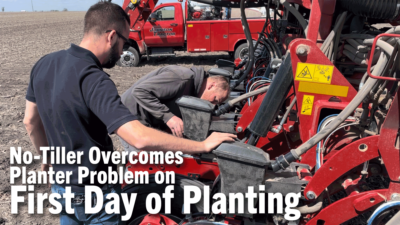For years, researcher and filmmaker Buz Kloot suspected something remarkable was happening under our feet.
|
Watch a preview of this video series by clicking here. |
His suspicion was based on interviews he conducted with farmers from various parts of the country – all of whom reported significant production and environmental benefits by simply improving the health of their soil.
“These farmers reported more consistent yields, lower input costs and higher net income,” said Kloot, a University of South Carolina research associate professor. “They weren’t sneaking out at night to fertilize and irrigate. I had to believe what I saw. And with each visit, these ‘anomalies’ amassed.”
Through his interviews, Kloot learned that these farmers typically don’t till; they use cover crops as an integral part of their management strategy; and they embrace crop diversity.
“With my background in mineral processing, I first viewed the soil as an inert medium to grow plants…sort of like a factory,” Kloot said. “From where I stood as a scientist, these farms looked like anomalies. I mean how do you get more from less, right?”
But with each subsequent interview, the research professor and filmmaker was driven to find out why, from a scientific perspective, these basic practices were so beneficial.
“The question is, can science explain the success that we see on these fields or will they remain anomalies?” Kloot asked.
He was determined to find out – to unlock the science of soil health – and to use the visual storytelling medium of videography to help others unlock the science, too.
In fall 2013, in cooperation with USDA’s Natural Resources Conservation Service, Kloot set out with video camera in hand to discover the science of soil health by interviewing some of the nation’s leading experts in soil biology, agronomy, entomology and soil ecology.
The stories resulting from his discoveries will soon be available on YouTube in a series of short video vignettes. They will feature interviews, observations and discoveries from scientists at the nation’s leading universities and research facilities. Watch a trailer of the project.
Kloot’s previous video work includes a wide range of soil and soil health educational and documentary videos including “The Under ‘Cover’ Farmers of Stanley County” and the “Soil Health Lessons in a Minute” video demonstration series.
Kloot admits that while his trek helped him answer many of his questions, many more remain. In fact, he said, many of our soil science questions may remain unanswered for generations to come.
“Frankly, we’ve just scratched the surface of the science behind soil health,” he said. “But the more we learn, the more remarkable and elegant the universe beneath our feet becomes. Personally, I’m hoping this video series will inspire a new generation of ‘soil explorers’ to seek answers to the questions that still remain.”
As the world population grows and as the world continues to lose some of its most productive land to development, Kloot said he sees improving soil health as the key to sustainable agriculture in the 21st century.
“DaVinci said that we know more about the movement of the celestial bodies than we know about the soil under foot,” Kloot said. “Fortunately, we have some incredible scientists who are determined to close that information gap. The ability for humankind to feed itself may well depend on it.”






Post a comment
Report Abusive Comment